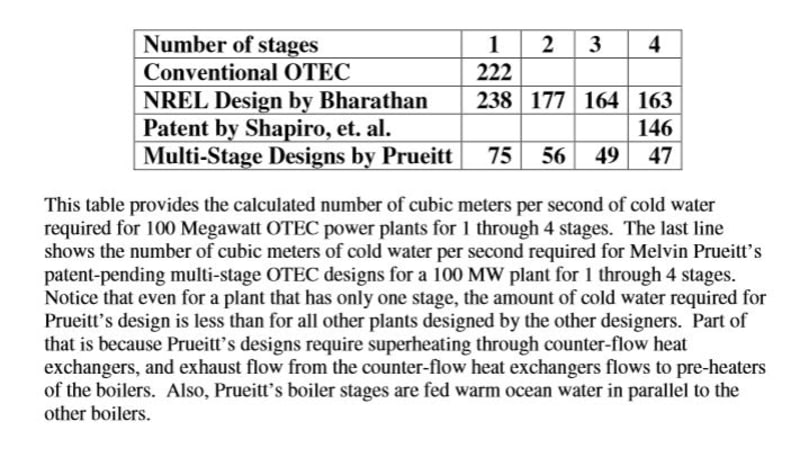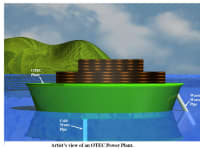For decades the scientific world has been dreaming of building enough 100 Megawatt OTEC (Ocean Thermal Energy Conversion) power plants to fill the oceans. Why not take the power from the world’s largest solar collector (the ocean)? Near the equator, the warm water provides power to generate electricity, while the deep cold water can condense the working fluid (refrigerant). But the energy required to pump the cold water up 1,000 meters makes the plants expensive and inefficient.
A conventional 100 MW OTEC plant requires about 222 cubic meters of cold water/second to be pumped up to the OTEC plant. That requires huge pipes and lots of power. Recently a new OTEC design was filed for a patent application, and it required only 146 cubic meters of cold water per second. And then I applied for a patent on my revolutionary design that will require only 49 cubic meters of cold water per second to produce 100 MW of power. This opens the door to the possibility of building many OTEC plants that can produce electricity cheaper than coal-fired plants.
This new method uses cold water in multi-stage condensers to condense the refrigerant flowing from the turbines and uses warm water in multi-stage boilers to boil the refrigerant. The cold water flows through the condenser stages in series, and the warm water flows through the boilers in parallel (to conserve energy). After flowing through the boilers and becoming high-pressure vapor, the refrigerant flows to counter-flow super-heaters where it becomes superheated (higher efficiency) before flowing to the turbines.
The attached drawing shows the logic of the heat paths. The cold seawater enters the First Stage Condenser at the lower left of the drawing. As the cold water flows through the first stage, it heats from 4 C to 10 C and then flows to the Second Stage Condenser. The refrigerant flowing from the turbine flows downward through channels in the First Stage Condenser and then is pumped to the right into the First Stage Boiler. After being boiled, the refrigerant flows up through the counter-flow super-heater and to the turbine.
Similar things happen as the cold water flows through the Second Stage Condenser and heats to 16 C, and the condensed refrigerant flows to the Second Stage and Third Stage boilers. Warm water flowing out the bottoms of the super-heaters flows to the bottoms of the boilers where it pre-heats the liquid refrigerant. The result is that this design requires only 49 cubic meters per second of cold water to produce 100 MW.
As mentioned, before my OTEC patent application, the most recent OTEC patent application was by Laurence J. Shapiro, et al, and showed a cold water flow of 146 cubic meters/second for 100 MW OTEC plants. My design requires only 49 cubic meters/second (33% of 146).
By transferring heat from warm ocean water by water vapor to the boiler and by transferring heat from condensers by water vapor to the cold water, we can desalinate large quantities of water.
Like this entry?
-
About the Entrant
- Name:Melvin Prueitt
- Type of entry:individual
- Software used for this entry:OTECNEW.F (a Fortran program)
- Patent status:pending








